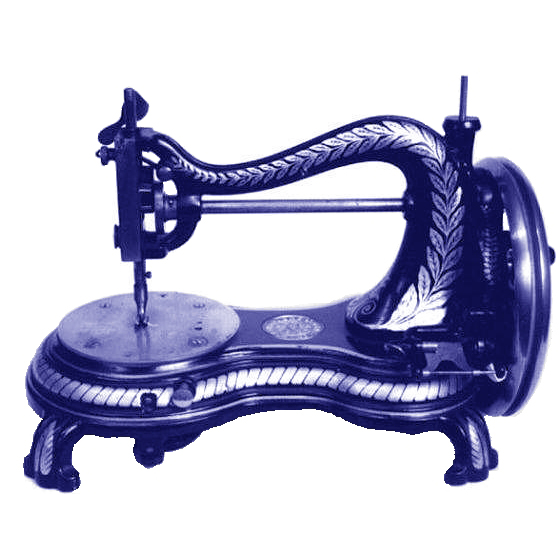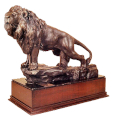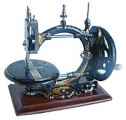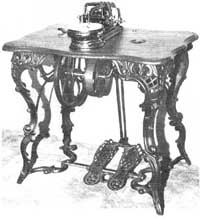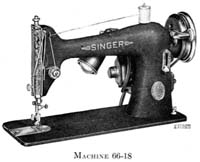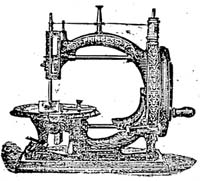Martin Gregory Lecture, 1996
Convention
HERE WE are at ISMACS '96 on the 150th anniversary of Elias Howe's master patent (registered September 10th 1846), a collection of sewing-machine collectors enthusing about our hobby. For those who do not collect, hoarding items from the past is incomprehensible.
So, "Why collect sewing machines?" For a few collecting is all: as long as they have the largest, most-unique, most-valuable collection they ask no more of it. For most there is some facet of their hobby which exerts a peculiar fascination for them.
One of the delights of meetings such as this is meeting people who think about sewing machines in ways which have not occurred to me.
I have called this session "What can we learn from the sewing machine?" I will start by telling you of some of the insights I have gained from my study of sewing machines.
The process of invention
At the start of the 19th century the processes of spinning thread and weaving cloth had been mechanised and concentrated in factories or mills.
The only step in the sequence from cotton plant or fleece to clothes which was still done entirely by hand was sewing up the cloth to make clothes. The first attempts to make a sewing machine (at the time of the Napoleonic wars) were aimed at imitating hand sewing and were doomed to failure.
The breakthrough came with Walter Hunt's invention of the lockstitch - a stitch which could not be made by hand. Hunt made his lockstitch with a grooved eye-pointed needle and a shuttle to carry the lower thread.
What a remarkable man Hunt must have been: a man who could invent a sewing machine, sell the right to patent it, and then walk away and invent something else.
He held patents for a machine for spinning flax/hemp, a coach alarm, a knife sharpener, a heating stove, an ice boat, a nail-making machine, a fountain pen, a safety pin, a bottle stopper and 16 other ideas.
Hunt seems not to have been interested in making money from his inventions and died a pauper.
In Elias Howe we have another inventor of meagre means. Whether he knew of Hunt's machine we do not know. Communications in those days were poor so, even though they were not all that far apart, the dissemination of ideas would be relatively slow.
Howe built his machine, made it work, patented it and then tried, with singular lack of success, to market it. Howe had better training and facilities than Hunt. and his surviving machines show a high standard of craftmanship.
By getting backing for litigation over infringements of his patent, he eventually benefitted from his patent and died a very rich man. Elias Howe was not the only genius in the Howe family. Amasa manufactured sewing machines commercially long before Elias and his sons-in-law set up their own company.
William Howe originated the Howe truss bridge, one of the first successful lattice girder bridges which enabled the railways to cover the American landscape. A third brother, Tyler Howe, produced the first spring bed using a mat of steel coil springs - not bad for one small-town farming- and-milling family.
The third inventor I admire is Allen Benjamin Wilson. Wilson, another New Englander, also came from humble beginnings. To the sewing machine he contributed the ideas of making the lockstitch by a rotating hook and the four-motion feed which appears on all modern machines.
In fact, Wilson's rotary hook was a more elegant solution than Howe's boat-shaped shuttle which came directly from contemporary loom technology. It is Wilson's ideas which have given us the modern machine.
Although the firm of Wheeler & Wilson flourished, it was the financier Nathaniel Wheeler who reaped most of the riches from the partnership.
After William O Grover, together with William E Baker, invented the two-thread chainstitch, most of the revolution had happened and evolution began. Only the single-thread chainstitch of James E A Gibbs (1857) was yet to come.
Improvements in technology
Howe's sewing machine was a technical curiosity which he took round the fairs of Massachusetts. For it to make its mark it had to be manufactured in quantity. The machine shop of the 1840s could produce individual machines but series production was limited by 'fitting' components at the bench; by filing to jigs and templates. Each machine was fitted up by hand and parts were not interchangeable.
Thus machines were expensive to make (the first Singer machine was $125, getting on for a year's wages), expensive to repair, not very reliable and not available in large quantities.
The industry which demanded interchangeable production was the small-arms industry. Nearly all the significant contributions to its realisation came from NE America and the system came to be known as the 'American system'.
One of the power houses of the interchangeable-manufacture movement was the Robbins & Lawrence works in Windsor, Vermont. Robbins & Lawrence's successors made sewing machines in Windsor and mechanics from the works were instrumental in setting up further sewing-machine manufactories.
The American Civil War gave a great boost to interchangeable manufacture through the arms industry. The end of the war led to an enormous increase in the production of sewing machines since new production facilities were available. Some small-arms companies such as Remington launched into sewing machines to utilise spare production capacity.
Surprising as it may seem, the Singer company was not in the forefront of interchangeable manufacture in the early days, being late converts to the 'American system'.
When the company did finally adopt it in the 1870s, the average production cost of a machine dropped to $12, though it still sold for $60. Probably the first really-high-precision domestic sewing machine with truly-interchangeable parts was the Willcox & Gibbs chainstitch machine which was initially made by Brown & Sharpe of Providence, Rhode Island.
Even after the mid-1860s many small production machines such as the Union were still hand 'fitted' and very far from interchangeable .
Producing large numbers of machines is of no value unless the machines can be distributed to agents and retailers.
The rise of the railway and the steam river boat provided this distnbution system and the expansion in sewing-machine production closely mirrors the expansion in railway mileage. All the big companies had rail access to their factories for the input of materials and output of machines. Singer had its own river steamer to supply machines to remote states.
Another problem created by the sewing machine was a demand for a suitable cotton thread. The simple spun thread of the time was too 'hairy', and frayed when fed through tension controls, the eye of the needle and round the shuttle.
A quality silk thread was available but was very expensive. The expansion in the numbers of sewing machines in the 1860s brought the problem to a head and G & W Clark of Paisley, Scotland, who had a mill at Newark, NJ, introduced a 'six- cord' cable thread made by twisting together three two-ply yarns. This was quickly followed by J & P Coats' 'best six-cord' thread and from then on the problem was solved.
The start of modern business practices
Whilst the production and distribution of sewing machines had to follow developments in other industries, the contribution of the sewing-machine industry to business practice was innovative and far reaching.
The Patent Combination: When Howe started to succeed with patent litigation against Singer and others, he soon found that, although he owned one master patent, he could not improve his machine without infringing the patents of others. As with all litigation, then as now, the only guaranteed winners were the lawyers.
In 1856 Orlando Potter, president of the Grover & Baker company, put forward the idea of a "combination" of sewing-machine manufacturers. The "Sewing Machine Combination" consisted of Elias Howe ; The Wheeler & Wilson Mfg Co; I M Singer & Co; and Grover & Baker .
The four pooled their patents and licensed other manufacturers to use them for $15 per machine. Howe's patent expired in 1867 and by 1876 all the other patents had expired and the "Combination" was wound up. Such patent pools and swaps still occur.
Aside from the Combination, each company continued to develop its own ideas and protect them with patents. The Singer company, in particular, bought samples of competitor's machines all over the world to check whether they infringed any of its patents. It acquired a fearsome reputation for suing and putting infringers out of business.
Hire Purchase: As more sewing machines came on the market more customers had to be found to purchase them.
In the 1850s the machines were very expensive and out of the reach of most families. Edward Clark, Singer's partner, solved the problem with the idea of hire-purchase sales.
In 1856 he wrote: "Why not rent a machine to the housewife and apply the rental fee to the purchase price of the machine? Her husband cannot accuse her of running him into debt since he is merely hiring or renting the machine and under no obligation to buy. Yet at the end of the period of the lease, he will own a sewing machine for the money."
The initial terms were $5 down and $5 a month. The scheme caught on immediately and thus hire purchase and all its attendant problems was born. The idea served the Singer Company well but today, with credit cards and ratings and everything available on the 'never-never', some might feel this idea is a mixed blessing.
Part Exchange: In 1857 Edward Clark came up with another good idea for increasing sales. He announced a "liberal plan of exchanging Singer's new and latest improved sewing machines for old or unimproved sewing machines of every kind."
In starting part exchange the Singer company took no risks with trade-in machines. "The old machine will be brought to our office in New York, and there be immediately broken up and destroyed."
Such remained company policy for well over a century. From the collector's point of view the offer led to the destruction of most of the early competition and robbed us of many desirable, but now unrepresented, machines.
The rise of the multinational: As Singer sought new markets for its machines, they were exported from the USA to Europe.
By the end of the 1850s most major American manufacturers had agents or offices in London and Paris. Singer licensed a French manufacturer in the late 1850s but the outcome was not a success and afterwards the Singer company always set up its own manufacturing plant for the market.
The first overseas plant was in Glasgow and developed into Clydebank, the largest sewing-machine factory in the world at the start of the 20th century.
Badging: Most of the early manufacturers, if licensed by the Combination, were proud of their product and labelled it appropriately. After 1870 when competition became intense, many manufacturers would "badge" their machines to carry the name of a local distributor or mail-order firm.
A few, including Singer and Wheeler & Wilson , never put other names on their machines. But for most, when an agent ordered 100-plus machines, they would be delivered with his personalised logo and decoration.
Fashion
The advent of the sewing machine completely changed the world of fashion. In 1850 the average family had a few simple working clothes and perhaps a Sunday suit.
The woman in the family expected to make and repair nearly all their clothes.
The rich employed a dressmaker, tailor or seamstress to make their clothes but one had to be very rich to have a large wardrobe.
With machine sewing the time required to make a garment was drastically reduced and, by putting the manufacturing processes together - cutting out, sewing, finishing - the 'ready-to-wear' clothing industry had started.
In 1860 the factory of a New Haven shirtmaker turned out 10,000 shirts per week using 400 seamstresses and 400 machines in place of 2,000 seamstresses. His labour costs dropped from $6,000 per week to $1,600 per week, even though the seamstress got $1 per week more.
The time taken to sew a shirt came down from 14.5 hours to l.25 hours. Assuming the machines cost around $100 each they would have paid for themselves in under three months.
The self-employed seamstress who bought a sewing machine could increase her productivity so that her standard of living improved even though she might be paying installments on the machine.
By 1870 the factories had specialised machines to make buttonholes, overseam, zig-zag, etc, and the standard machine had a wide range of attachments for embroidery, hemming, braiding, etc.
The popularity and availability of crinolines and other complex ladies dresses in the late 19th century was due to the advent of the sewing machine and its attachments. Other allied industries such as shoes and hats had specialised sewing machines developed for them very rapidly. By 1875 it is difficult to find a sewing operation which was not capable of being carried out by machine.
To sell millions of machines to the home buyer was the task of the decades after 1875. With the methods of manufacture and distribution solved, the information revolution of the time enabled sewing-machine advertising to get into every home through newspapers and mail-order catalogues. The larger companies opened shops in every town of significant size and provided tuition and servicing for machines.
By the end of the 19th century the Singer company had over 900 shops in Great Britain alone. Singer provided free loans to schools to encourage girls to grow up familiar with its sewing machines.
To help spread the latest fashion, paper patterns for dresses brought the latest fashions to the home dressmaker (Butterick from 1875). Machines, patterns and fabrics were all available by mail order as was the beginning of the ready-to-wear fashion clothes industry.
Decoration and industrial design
By 1850 the iron-founding industry had become very skilled in producing complicated castings. On the machinery side, steam-engine cylinders with cast-in passages, and on the decorative side, complex floral and architectural motifs, were readily available. The 1851 (Crystal Palace) exhibition was awash with decorated cast iron.
The first sewing machines were for industry and the iron castings used were of simple functional design. In many cases, eg the early Singers, their structural design would not be bettered today.
Some achieved real elegance of functional design. The standard finish was black japanning - the only finish available - but from the start they seem to have been decorated by lining out (common on other machinery of the time) or painted bunches of flowers, etc.
From the late 1860s some had fashionable bits of mother-of-pearl embedded in the black- japanned base. Towards the end of the century the bits of mother-of-pearl were replaced with carefully-cut-out geometrical figures in mother-of- pearl.
The alternative to painting and mother-of- pearl was to use very ornate castings. In America we have foliage machines and machines with dolphins, squirrels and horses. Probably the most outlandish machines here were Kimball & Morton's 'Lion' machines - a standard vibrating- shuttle design in an eyecatching riot of cast iron!
As production rose the painted lines and flowers were replaced with transfers which could be applied quickly and fixed with a layer of varnish. The same machine could appear with many different schemes of decoration merely by changing the design of the transfer: thus machines with a long production life could appear with simple gold lining, daisies, art nouveau designs, Egyptian pharoahs and art deco flowers.
In many cases, decoration forms the best way of dating machines as most major manufacturers adopted the same style of decoration at the same time period.
In the early years of the sewing machine many small machines were made but were marketed as adult machines big enough to do a full-size job.
No one, for instance, thinks of the Raymond 'New England' machine as a toy though it makes an untwisted single-thread chainstitch which easily unravels, is prone to drop stitches and has very little room under the arm.
Many manufacturers produced scaled-down versions of their standard machines but I do not think they thought of the small machines as toys, more as a portables. There were, of course, small travelling sewing machines such as the Moldacot advertised for adult use.
Conclusion
There is not much literature on the sewing machine so researching these cross-links, though rewarding, is time consuming. In trying to answer one question I always find I end up with more questions to answer.
I hope you will write up your discoveries for ISMACS News, so that we can add to our corpus of knowledge about a machine which was so important an addition to the home as to be dubbed 'a servant in the house'.
